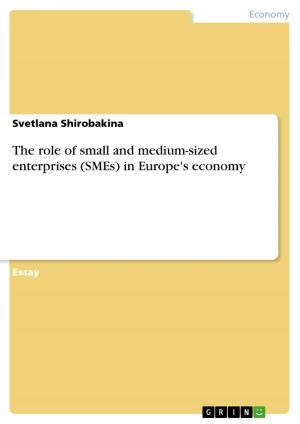| Author: | Maria Kimme | ISBN: | 9783638350099 |
| Publisher: | GRIN Publishing | Publication: | February 14, 2005 |
| Imprint: | GRIN Publishing | Language: | English |
| Author: | Maria Kimme |
| ISBN: | 9783638350099 |
| Publisher: | GRIN Publishing |
| Publication: | February 14, 2005 |
| Imprint: | GRIN Publishing |
| Language: | English |
Seminar paper from the year 2001 in the subject Business economics - Investment and Finance, grade: 1.4, Maastricht University, course: Finance, 20 entries in the bibliography, language: English, abstract: Every week, if not more often, the financial press reports intentions of firms to merge. If we hear the notation 'mergers and acquisitions', various names of companies will come to our minds, such as Mannesmann and Vodafone, Volkswagen and Audi, Daimler-Benz and Chrysler, to name just a few. Some of those can be considered successful, while others represented a disaster to stakeholders. Employees were laid off, plants closed, supplier relationships cancelled, customers confused, and, most of all, shareho lder value destroyed. In 2000, 83% of all mergers did not generate benefits to the stockholders, 50% even produced losses. This situation gives rise to many questions. Mainly, it has to be clarified, what the underlying reasons of those failures to create stockholder value are. Connected with this is the discussion about the corporate cultures of the two merging companies and the influence of their differences on the outcome of the merger. Especially interesting in this matter, is the distinction between hard and soft facts in the merging companies. The underlying patterns will be clarified and the connection will be explained with the example of the fusion of Daimler-Benz AG and Chrysler Corp. on November 17 th in 1998. This paper will continue with the definition and description of hard and soft facts to be considered when approaching a possible merger. It will describe, how the soft facts can overshadow any possible benefit arising from the hard facts, if managed poorly. After that, some solutions will be provided, in order to overcome arising difficulties. To underline those theoretical thoughts, the case study of DaimlerChrysler will be provided and applied. Concluding, this paper will provide an answer on the above mentioned question.
Seminar paper from the year 2001 in the subject Business economics - Investment and Finance, grade: 1.4, Maastricht University, course: Finance, 20 entries in the bibliography, language: English, abstract: Every week, if not more often, the financial press reports intentions of firms to merge. If we hear the notation 'mergers and acquisitions', various names of companies will come to our minds, such as Mannesmann and Vodafone, Volkswagen and Audi, Daimler-Benz and Chrysler, to name just a few. Some of those can be considered successful, while others represented a disaster to stakeholders. Employees were laid off, plants closed, supplier relationships cancelled, customers confused, and, most of all, shareho lder value destroyed. In 2000, 83% of all mergers did not generate benefits to the stockholders, 50% even produced losses. This situation gives rise to many questions. Mainly, it has to be clarified, what the underlying reasons of those failures to create stockholder value are. Connected with this is the discussion about the corporate cultures of the two merging companies and the influence of their differences on the outcome of the merger. Especially interesting in this matter, is the distinction between hard and soft facts in the merging companies. The underlying patterns will be clarified and the connection will be explained with the example of the fusion of Daimler-Benz AG and Chrysler Corp. on November 17 th in 1998. This paper will continue with the definition and description of hard and soft facts to be considered when approaching a possible merger. It will describe, how the soft facts can overshadow any possible benefit arising from the hard facts, if managed poorly. After that, some solutions will be provided, in order to overcome arising difficulties. To underline those theoretical thoughts, the case study of DaimlerChrysler will be provided and applied. Concluding, this paper will provide an answer on the above mentioned question.















